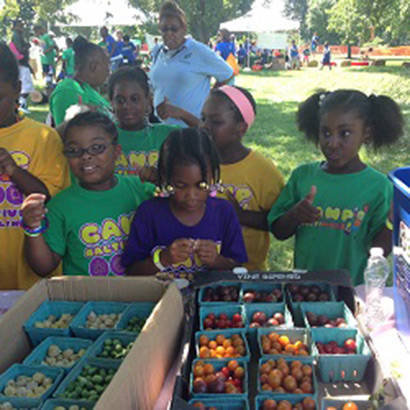
You may have seen the popular YouTube video, 5 Extra Years, trending the past few years. If not, take a few minutes to watch. What’s the message behind this video? It’s simple and it’s brutally honest-- this might be the first generation of children to live shorter lives than their parents. Why? Childhood obesity.
In Baltimore City, like cities all across the country, they know this all too well. You can see it throughout the community and in its neighborhoods where access to healthy foods and physical activity opportunities are not always easy to find. Food deserts exist in the areas that need fresh fruits and vegetables the most and safety is a concern when walking to and from schools, parks and recreational programs. These challenges, as well a mixture of other contributing factors are continuing to lead to childhood obesity in Baltimore City and across the nation.
To address this problem and the challenges, the Baltimore City Recreation Department is taking on-going steps to create change and provide healthier foods and access to physical activity to youth in their community. To accomplish this and give youth those 5 years back, BCRD pledged to “Commit to Health” with NRPA at their park and recreation sites in 2015. One year into their commitment, they have seen success through a variety of implementation strategies including focusing on engaging and motivating staff, reaching out to parents and caregivers through focus groups and communication, and educating youth about the importance of making healthy lifestyle decisions.
Youth have a tendency to look to teachers and educators as role models. Understanding the importance of having staff buy-in and support for the HEPA standards, BCRD leadership took time to engage, train and motivate staff themselves to lead healthier lifestyles and be the best roles models they could possibly be for children in their programs. To accomplish this, BCRD launched staff workout sessions during lunch to provide physical activity opportunities to summer camp staff. The workout sessions were so successful that they expanded to early morning and evening sessions, reaching additional staff members and creating support for the importance of physical activity. In addition, they provided resources to each recreation center by sharing articles, activity pages, healthy recipes and fun exercise videos with staff each week, inspiring them to create opportunities to explore healthy eating and physical activity during their programs. These efforts accomplished two key things that helped to successfully implement HEPA; 1) staff supported the reasoning behind implementing the HEPA standards, experiencing first-hand benefits of physical activity and nutritious foods; and 2) staff were educated on healthy eating and physical activity so that they could become teachers and relay the information to youth.
In addition to creating staff buy-in, BCRD knew the importance of engaging the family unit (children and parents/caregivers) in the implementation process. BCRD implored fun and engaging strategies to connect youth and families to the healthy eating and physical activity standards. They created "Tasty Tuesdays" to introduce groups to different healthy foods each week. They utilized the OrganWise Guys program to educate youth about the organs in the body, how to take care of the body, and the role of healthy foods and physical activity. They sent home newsletters to parents and encouraged families to create healthy recipes at home.
Success did not come without challenge. BCRD quickly learned that not one strategy worked for each center. The demographics of the recreation centers and the individual youth at each center were the driving force that determined the content and focus of the Center's programming. To address this challenge, focus groups were held with parents and children to gauge their knowledge and expectations of the OST and summer camp programming. These focus groups gave parents and caregivers a voice, expressing their views on health and physical fitness and allowing them to weigh-in on the standards being implemented, building support from all parties involved and allowing each recreation center to gain an understanding of the wants and needs of the community.
Feedback helped staff to determine that parents support the implementation of the HEPA standards and like the healthy changes their children have been making. They also learned that children like being active, getting to play outside, exploring how food grows and trying new foods. Within the first year of implementing Commit to Health, BCRD successfully created buy-in from staff, parents and children. This buy-in and support will continue to propel the movement for healthier foods and more active programs for years to come.
